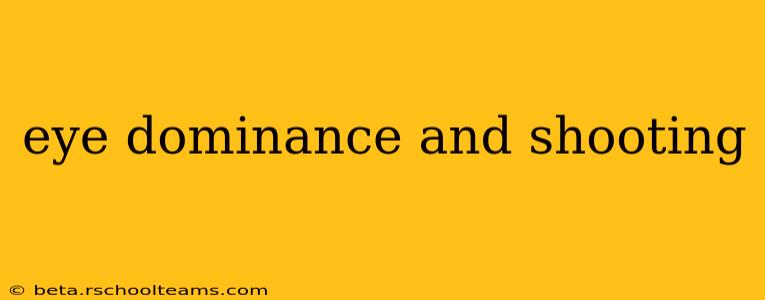Eye dominance plays a crucial, often overlooked, role in shooting accuracy. Understanding your eye dominance and how it affects your shooting technique is key to improving your precision and overall performance, whether you're a seasoned marksman or just starting out. This guide delves into the intricacies of eye dominance, its impact on shooting, and practical strategies for overcoming potential challenges.
What is Eye Dominance?
Eye dominance refers to the eye your brain preferentially uses to aim and focus. It's not necessarily the eye with better visual acuity; rather, it's the eye that takes the lead in guiding your actions, particularly in tasks requiring precise aiming, like shooting a rifle, bow, or even playing pool. Most people are either right-eye dominant or left-eye dominant, though some individuals exhibit mixed dominance.
Identifying Your Eye Dominance
Several simple tests can help you determine your eye dominance:
-
The Hole-in-the-Hand Test: Extend your arm and create a small triangle shape with your thumb and index finger. Focus on a distant object through this triangle. Close one eye at a time. The eye through which the object remains centered in the triangle is your dominant eye.
-
The Pointing Test: Extend your arm and point at a distant object. Close one eye at a time. The eye that keeps the point aligned with the object is your dominant eye.
-
The Dominant Eye Patch Test: Cover one eye at a time while aiming at a target. Note which eye provides better accuracy.
Accurately determining your eye dominance is the first step towards optimizing your shooting technique.
Eye Dominance and Shooting Performance: The Connection
The relationship between eye dominance and shooting performance is significant. When your dominant eye aligns with your shooting hand, you experience a natural synergy, leading to improved accuracy and faster target acquisition. This is known as cross-dominance when your dominant eye and shooting hand are on opposite sides.
Challenges of Cross-Dominance in Shooting
Cross-dominance presents unique challenges for shooters. The brain receives conflicting signals from the dominant eye and the hand used to hold the weapon. This can result in:
- Inconsistent aiming: Difficulty aligning the sights with the target, leading to missed shots.
- Poor accuracy: Reduced precision and grouping of shots.
- Frustration and difficulty learning: Developing proper shooting form can be more challenging and slower.
Strategies for Overcoming Cross-Dominance
Fortunately, several effective strategies can mitigate the challenges of cross-dominance:
-
Adjusting your shooting stance: Experiment with different stances to find one that allows for a more natural alignment of your dominant eye with the sights. This might involve shifting your body position slightly.
-
Using a different shooting technique: For instance, a left-handed shooter with right eye dominance may find it easier to shoot with a modified grip or stance.
-
Employing specialized equipment: Certain sights or scopes can be better suited for individuals with cross-dominance, aiding in better alignment.
-
Practice and consistency: Consistent practice is essential to develop muscle memory and compensate for the challenges of cross-dominance. Start with slow, deliberate shots, gradually increasing your speed as your accuracy improves.
-
Seeking professional guidance: Consider consulting with a shooting instructor or coach who can provide personalized advice and help develop an effective shooting technique tailored to your specific eye dominance and skill level.
Conclusion: Mastering Your Aim Through Understanding
Understanding your eye dominance and its impact on your shooting is vital for improving accuracy and overall performance. By identifying your dominance, understanding its potential challenges, and implementing appropriate strategies, you can overcome hurdles and unlock your full potential as a shooter. Remember, consistent practice and potentially seeking expert advice are key elements in achieving success.
